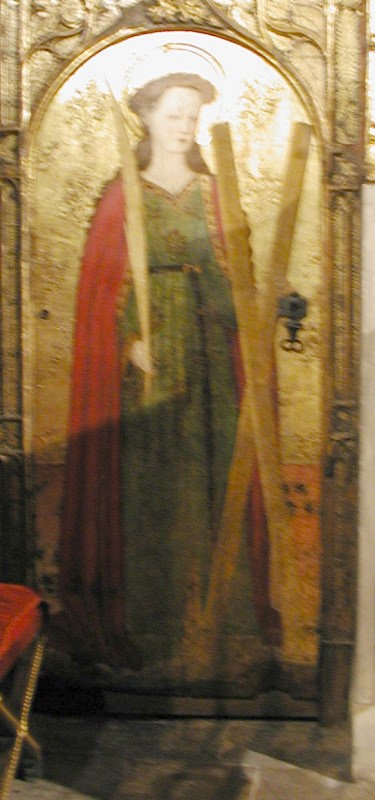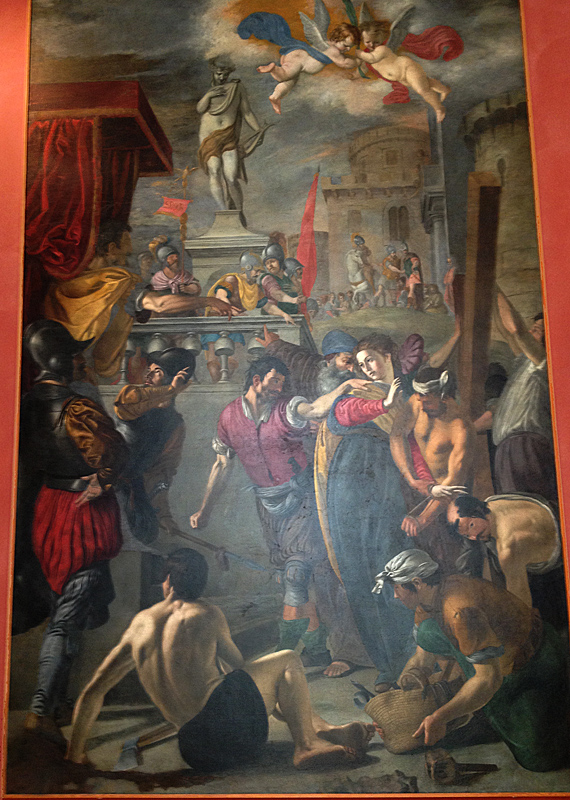The Barcelona Eulalia was said to be martyred on February 12, but the earliest account of her life is from the 7th century and is merely a copy of Prudentius.2 Most of the "Eulalia" images one sees are from Catalonia or its one-time dependencies. They draw their details from different aspects of different legends.
Some of the legends say Eulalia was tortured while suspended on an equuleus, a torturer's rack, whereas others use the word crux.3 Crux can refer to any sort of wooden instrument of execution, but usually it means "cross," so eventually some narrative images picture the men torturing Eulalia as she hangs on a cross saltire, as in the second picture at right and the altarpiece above. The cross saltire then becomes one of her attributes, as in the first picture at right.
In the 9th-century Cantilène d'Eulalie (see below) the saint is thrown into a fire that fails to consume her and she is then beheaded. This account appears to be the source of the statue in Oviedo in which her attribute is a maquette of an horno, an outdoor oven common in the Spanish countryside. It may also explain images that place her on a gridiron like St. Lawrence's. (See the far right panel in the second register of the altarpiece at the top of this page.)
The vita published in the Acta Sanctorum says the prefect Dacian had Eulalia flogged before moving on to the other torments.4 The flogging is illustrated in this painting and in the altarpiece at the top of this page.
In Prudentius after the saint's death snow falls thickly to cover her body, which Gregory of Tours says had been stripped naked.5 The nakedness is treated respectfully in medieval images, but some later works dispense with the snow and present her body to a prurient gaze. Thus in St. Eulalia on the Bonfire (1519) Ordoñez stretches her out naked on the gridiron like a lounging odalisque. And Waterhouse's Eulalia (third picture at right) has her dead and prone, her lustrous body exposed to the elements and the view of gawking boys.
In some portraits St. Eulalia has a crown (example) and/or a book or scroll.
-
Eulalia was a perfect girl.
She had a beautiful body, a soul still more beautiful. -
God's enemies wanted to vanquish her.
They wanted to make her serve the devil. -
But she did not listen to bad counselors
Who advised her to deny God, who lives in Heaven. -
Not gold, nor silver, nor finery
Nor the king's threats and entreaties -
Could ever make the girl
Stop loving the service of God. -
And so she was brought before Maximian,
Who was king of the pagans in those days. -
He exhorts her, though without success,
To give up the name of Christian. -
She endures the torment of the fire.
She would rather endure the torture -
Than lose her virginity.
Thus she died in glory. -
They threw her in the fire so she would burn quickly.
She had done nothing wrong, so the fire did not consume her. -
The pagan king would not give in.
He ordered that she be beheaded with a sword. -
The demoiselle did not refuse.
She wanted to leave this earth, prayed Christ that she could. -
The demoiselle did not refuse.
She wanted to leave this earth, prayed Christ that she could. -
In the form of a dove she flew to Heaven.
Let us all pray that she will deign to pray for us -
And that Christ will have mercy on us
After our death, and let us come to him - In his mercy.
Prepared in 2014 by Richard Stracke, Emeritus Professor of English, Augusta University, revised 2015-10-31, 2017-04-12, 2018-04-22.
Altarpiece of St. Eulalia, Cathedral of Palma de Mallorca, 1350. See the description page.
OTHER IMAGES

Portrait of St. Eulalia in Barcelona Cathedral – See description page

17th century painting of the martyrdom – see the description page.

John William Waterhouse, St. Eulalia, 1885 – See description page
ATTRIBUTES
- Cross saltire (i.e., X-shaped)
- A Spanish horno (outdoor oven)
MORE IMAGES
- Statue in Santa Ojala, León, Spain.
DATES
- Feast days: December 10 (Eulalia of Mérida), February 12 (Eulalia of Barcelona).
ST. EULALIA IN THE ROMAN MARTYROLOGY:
December 10: In Merida, Spain, the passion of St. Eulalia, Virgin. Under the Emperor Maximian and at the order of the Prefect Dacian, when she was twelve years old she was subjected to many tortures. She was put on the rack, her nails were ripped out, burning brands were applied to her sides, and she died in the enveloping fire.
February 12: In Barcelona, Spain, St. Eulalia, Virgin. In the time of the Emperor Diocletian she was tortured with fire and the rack. Then she attained the glorious crown of martyrdom when they nailed her to a cross.
OTHER BIOGRAPHY
- Prudentius, Peristephanon, Carmen III.
- Gregory of Tours, ¶90 of Glory of the Martyrs.
- La Cantilène de Sainte Eulalie: Follow this link for the original. At left is my English translation.
- Acta Sanctorum: February vol. 2, 576-80.
NOTES
1 Peristephanon, III, 131-160.
2 Butler, IV, 530. Acta Sanctorum, February vol. 2, 576.
3 Acta Sanctorum, February vol. 2, 576-77.
4 Ibid., 577.
5 Peristephanon, III, 176-80. Glory of the Martyrs, 114.
